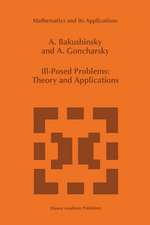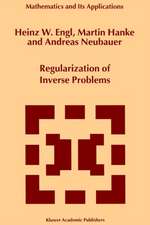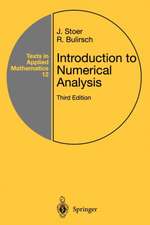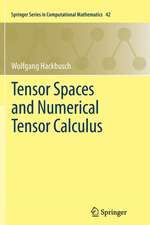Mathematical Analysis and Numerical Methods for Science and Technology: Volume 1 Physical Origins and Classical Methods
Traducere de I.N. Sneddon Autor Robert Dautray Contribuţii de P. Benilan Autor Jacques Louis Lions Contribuţii de M. Cessenat, A. Gervat, A. Kavenoky, H. Lanchonen Limba Engleză Paperback – 22 noi 1999
| Toate formatele și edițiile | Preț | Express |
|---|---|---|
| Paperback (6) | 471.93 lei 39-44 zile | |
| Springer Berlin, Heidelberg – 22 noi 1999 | 471.93 lei 39-44 zile | |
| Springer Berlin, Heidelberg – 22 noi 1999 | 471.98 lei 39-44 zile | |
| Springer Berlin, Heidelberg – 22 noi 1999 | 476.18 lei 39-44 zile | |
| Springer Berlin, Heidelberg – 22 noi 1999 | 480.71 lei 39-44 zile | |
| Springer Berlin, Heidelberg – 22 noi 1999 | 487.73 lei 39-44 zile | |
| Springer Berlin, Heidelberg – 22 noi 1999 | 494.18 lei 39-44 zile |
Preț: 487.73 lei
Preț vechi: 609.66 lei
-20% Nou
Puncte Express: 732
Preț estimativ în valută:
93.33€ • 99.80$ • 77.81£
93.33€ • 99.80$ • 77.81£
Carte tipărită la comandă
Livrare economică 14-19 aprilie
Preluare comenzi: 021 569.72.76
Specificații
ISBN-13: 9783540660972
ISBN-10: 3540660976
Pagini: 740
Ilustrații: 1
Dimensiuni: 155 x 235 x 39 mm
Greutate: 0.96 kg
Ediția:2000
Editura: Springer Berlin, Heidelberg
Colecția Springer
Locul publicării:Berlin, Heidelberg, Germany
ISBN-10: 3540660976
Pagini: 740
Ilustrații: 1
Dimensiuni: 155 x 235 x 39 mm
Greutate: 0.96 kg
Ediția:2000
Editura: Springer Berlin, Heidelberg
Colecția Springer
Locul publicării:Berlin, Heidelberg, Germany
Public țintă
ResearchDescriere
In
the
first
years
of
the
1970's
Robert
Dautray
engaged
in
conversations
with
Jacques
Yvon,
High-Commissioner
of
Atomic
energy,
of
the
necessity
of
publish
ing
mathematical
works
of
the
highest
level
to
put
at
the
disposal
of
the
scientific
community
a
synthesis
of
the
modern
methods
of
calculating
physical
phe
nomena.
It
is
necessary
to
get
away
from
the
habit
of
treating
mathematical
concepts
as
elegant
abstract
entities
little
used
in
practice.
We
must
develop
a
technique,
but
without
falling
into
an
impoverishing
utilitarianism.
The
competence
of
the
Commissariat
a
I'Energie
Atomique
in
this
matter
can
provide
a
support
of
exceptional
value
for
such
an
enterprise.
The
work
which
I
have
the
pleasure
to
present
realises
the
synthesis
ofmathemat
ical
methods,
seen
from
the
angle
of
their
applications,
and
of
use
in
designing
computer
programs.
It
should
be
seen
as
complete
as
possible
for
the
present
moment,
with
the
present
degree
of
development
of
each
of
the
subjects.
It
is
this
specific
approach
which
creates
the
richness
of
this
work,
at
the
same
time
a
considerable
achievement
and
a
harbinger
of
the
future.
The
encounter
to
which
it
gives
rise
among
the
originators
of
mathematical
thought,
the
users
of
these
concepts
and
computer
scientists
will
be
fruitful
for
the
solution
of
the
great
problems
which
remain
to
be
treated,
should
they
arise
from
the
mathematical
structure
itself
(for
example
from
non-linearities)
or
from
the
architecture
of
computers,
such
as
parallel
computers.
Cuprins
I.
Physical
Examples.-
A.
The
Physical
Models.-
§
1.
Classical
Fluids
and
the
Navier-Stokes
System.-
1.
Introduction:
Mechanical
Origin.-
2.
Corresponding
Mathematical
Problem.-
3.
Linearisation.
Stokes’
Equations.-
4.
Case
of
a
Perfect
Fluid.
Euler’s
Equations.-
5.
Case
of
Stationary
Flows.
Examples
of
Linear
Problems.-
6.
Non-Stationary
Flows
Leading
to
the
Equations
of
Viscous
Diffusion.-
7.
Conduction
of
Heat.
Linear
Example
in
the
Mechanics
of
Fluids.-
8.
Example
of
Acoustic
Propagation.-
9.
Example
with
Boundary
Conditions
on
Oblique
Derivatives.-
Review.-
§2.
Linear
Elasticity.-
1.
Introduction:
Elasticity;
Hyperelasticity.-
2.
Linear
(not
Necessarily
Isotropic)
Elasticity.-
3.
Isotropic
Linear
Elasticity
(or
Classical
Elasticity).-
4.
Stationary
Problems
in
Classical
Elasticity.-
5.
Dynamical
Problems
in
Classical
Elasticity.-
6.
Problems
of
Thermal
Diffusion.
Classical
Thermoelasticity.-
Review.-
§3.
Linear
Viscoelasticity.-
1.
Introduction.-
2.
Materials
with
Short
Memory.-
3.
Materials
with
Long
Memory.-
4.
Particular
Case
of
Isotropic
Media.-
5.
Stationary
Problems
in
Classical
Viscoelasticity.-
Review.-
§4.
Electromagnetism
and
Maxwell’s
Equations.-
1.
Fundamental
Equations
of
Electromagnetism.-
2.
Macroscopic
Equations:
Electromagnetism
in
Continuous
Media.-
3.
Potentials.
Gauge
Transformation
(Case
of
the
Entire
Space
IR3x
×
IRt).-
4.
Some
Evolution
Problems.-
5.
Static
Electromagnetism.-
6.
Stationary
Problems.-
Review.-
§5.
Neutronics.
Equations
of
Transport
and
Diffusion.-
1.
Problems
of
the
Transport
of
Neutrons.-
2.
Problems
of
Neutron
Diffusion.-
3.
Stationary
Problems.-
Review.-
§6.
Quantum
Physics.-
1.
The
Fundamental
Principles
of
Modelling.-
2.
Systems
Consisting
of
One
Particle.-
3.
Systems
of
Several
Particles.-
Review.-
Appendix.
Concise
Elements
Concerning
Some
Mathematical
Ideas
Used
in
this
§6.-
Appendix
“Mechanics”.
Elements
Concerning
the
Problems
of
Mechanics.-
§1.
Indicial
Calculus.
Elementary
Techniques
of
the
Tensor
Calculus.-
1.
Orientation
Tensor
or
Fundamental
Alternating
Tensor
in
IR3.-
2.
Possibilities
of
Decompositions
of
a
Second
Order
Tensor.-
3.
Generalized
Divergence
Theorem.-
4.
Ideas
About
Wrenches.-
§2.
Notation,
Language
and
Conventions
in
Mechanics.-
1.
Lagrangian
and
Eulerian
Coordinates.-
2.
Notions
of
Displacement
and
of
Strain.-
3.
Notions
of
Velocity
and
of
Rate
of
Strain.-
4.
Notions
of
Particle
Derivative,
of
Acceleration
and
of
Dilatation.-
5.
Notions
of
Trajectory
and
of
Stream
Line.-
§3.
Ideas
Concerning
the
Principle
of
Virtual
Power.-
1.
Introduction:
Schematization
of
Forces.-
2.
Preliminary
Definitions.-
3.
Fundamental
Statements.-
4.
Theory
of
the
First
Gradient.-
5.
Application
to
the
Formulation
of
Curvilinear
Media.-
6.
Application
to
the
Formulation
of
the
Theory
of
Thin
Plates.-
Linear
and
Non-Linear
Problems
in
§1
to
§6
of
this
Chapter
IA.-
B.
First
Examination
of
the
Mathematical
Models.-
§
1.
The
Principal
Types
of
Linear
Partial
Differential
Equations
Seen
in
Chapter
IA.-
1.
Equation
of
Diffusion
Type.-
2.
Equation
of
the
Type
of
Wave
Equations.-
3.
Schrödinger
Equation.-
4.
The
Equation
Au
=
f
in
which
A
is
a
Linear
Operator
not
Depending
on
the
Time
and
f
is
Given
(Stationary
Equations).-
§2.
Global
Constraints
Imposed
on
the
Solutions
of
a
Problem:
Inclusion
in
a
Function
Space;
Boundary
Conditions;
Initial
Conditions.-
1.
Introduction.
Function
Spaces.-
2.
Initial
Conditions
and
Evolution
Problems.-
3.
Boundary
Conditions.-
4.
Transmission
Conditions.-
5.
Problems
Involving
Time-Derivatives
of
the
Unknown
Function
u
on
the
Boundary.-
6.
Problems
of
Time
Delay.-
Review
of
Chapter
IB.-
II.
The
Laplace
Operator
Introduction.-
§1.
The
Laplace
Operator.-
1.
Poisson’s
Equation.-
2.
Examples
in
Mechanics
and
Electrostatics.-
3.
Green’s
Formulae:
The
Classical
Framework.-
4.
The
Laplacian
in
Polar
Coordinates.-
§2.
Harmonic
Functions.-
1.
Definitions.
Examples.
Elementary
Solutions.-
2.
Gauss’
Theorem.
Formulae
of
the
Mean.
The
Maximum
Principle.-
3.
Poisson’s
Integral
Formula;
Regularity
of
Harmonic
Functions;
Harnack’s
Inequality.-
4.
Characterisation
of
Harmonic
Functions.
Elimination
of
Singularities.-
5.
Kelvin’s
Transformation;
Application
to
Harmonic
Functions
in
an
Unbounded
Set;
Conformai
Transformation.-
6.
Some
Physical
Interpretations
(in
Mechanics
and
Electrostatics).-
§3.
Newtonian
Potentials.-
1.
Generalities
on
the
Newtonian
Potentials
of
a
Distribution
with
Compact
Support.-
2.
Study
of
Local
Regularity
of
Solutions
of
Poisson’s
Equation.-
3.
Regularity
of
Simple
and
Double
Layer
Potentials.-
4.
Newtonian
Potential
of
a
Distribution
Without
Compact
Support.-
5.
Some
Physical
Interpretations
(in
Mechanics
and
Electrostatics).-
§4.
Classical
Theory
of
Dirichlet’s
Problem.-
1.
Generalities
on
Dirichlet’s
Problem
P(?,?,)
in
the
Case
?
Bounded:
Classical
Solution,
Examples,
Outline
of
Perron’s
Method,
Generalized
Solutions,
Regular
Point
of
the
Boundary,
Barrier
Function.-
2.
Generalities
on
the
Dirichlet
Problem
P(?,?,
f)
and
the
Green’s
Function
of
?,
a
Bounded
Open
Set.-
3.
Generalities
on
Dirichlefs
Problem
in
an
Unbounded
Open
Set.-
4.
The
Neumann
Problem;
Mixed
Problem;
Hopf’s
Maximum
Principle;
Examples.-
5.
Solution
by
Simple
and
Double
Layer
Potentials:
Fredholm’s
Integral
Method.-
6.
Sub-Harmonic
Functions.
Perron’s
Method.-
§5.
Capacities.-
1.
Interior
and
Exterior
Capacity
Operators.-
2.
Electrical
Equilibrium;
Coefficients
of
Capacitance.-
3.
Capacity
of
a
Part
of
an
Open
Set
in
IRn.-
§6.
Regularity.-
1.
Regularity
of
the
Solutions
of
Dirichlet
and
Neumann
Problems.-
2.
Analytic
Regularity
and
Trace
on
the
Boundary
of
a
Harmonic
Function.-
3.
Dirichlet
Problem
with
Given
Measures
or
Discontinuous
Functions.
Herglotz’s
Theorem.-
4.
Neumann
Problem
with
Given
Measures.-
5.
Dependence
of
Solutions
of
Dirichlet
Problems
as
a
Function
of
the
Open
Set:
Hadamard’s
Formula.-
§7.
Other
Methods
of
Solution
of
the
Dirichlet
Problem.-
1.
Case
of
a
Convex
Open
Set:
Neumann’s
Integral
Method.-
2.
Alternating
Procedure
of
Schwarz.-
3.
Method
of
Separation
of
Variables.
Harmonic
Polynomials.
Spherical
Harmonic
Function.-
4.
Dirichlet’s
Method.-
5.
Symmetry
Methods
and
Method
of
Images.-
§8.
Elliptic
Equations
of
the
Second
Order.-
1.
The
Divergence
Form,
Green’s
Formula.-
2.
Different
Concepts
of
Solutions,
Boundary
Value
Problems,
Transmission
Conditions.-
3.
General
Results
on
the
Regularity
of
Elliptic
Problems
of
the
Second
Order.-
4.
Results
on
Existence
and
Uniqueness
of
Solutions
of
Strictly
Elliptic
Boundary
Value
Problems
of
the
Second
Order
on
a
Bounded
Open
Set.-
5.
Harnack’s
Inequality
and
the
Maximum
Principle.-
6.
Green’s
Functions.-
7.
Helmholtz’s
Equation.-
Review
of
Chapter
II.-
Table
of
Notations.-
of
Volumes
2–6.



















